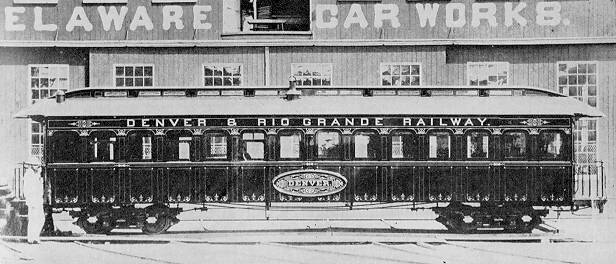Jackson & SharpJackson & Sharp Company
|
 |
|
Boston, Hartford & Erie coach built by Jackson & Sharp about 1865. |
The firm was reorganized in 1869 as the Jackson and Sharp Car Company, a joint stock company, {424} and Sharp retired in 1870. Jackson, a shrewd businessman, soon acquired most of the shares and developed the Delaware Car Works into a formidable enterprise. He erected the larger Delaware Car Works facility at the foot of 8th Street, where Jackson & Sharp built the first narrow gauge cars in this country for the Denver & Rio Grande Railway in 1871. In the following years, Jackson & Sharp were to build a good many cars for this railroad. They would produce more than 400 narrow gauge passenger cars by 1876.
 |
| Denver & Rio Grande narrow gauge Coach Denver built 1871 by Jackson & Sharp. Too narrow (7' wide) for the usual two seats on each side of a center aisle, this car had two seats on one side and one on the other. The arrangement was switched at the middle of the car to “maintain balance.” |
But the financial panic of 1873 so reduced car sales that by 1875 the company was down to 40 employees from 600 and planned to close down completely by summer unless new orders were received. They diversified by acquiring the Christina River Shipyards, while continuing to build sash and other millwork for buildings. Sharp also became involved in the management of the Woodruff Sleeping Car Company.
In 1876 Jackson & Sharp received a Centennial Award at the Philadelphia Centennial Exhibition, in the “railway plant, rolling stock, engines” category for its passenger, boudoir, and library cars. And by 1880 they were producing 400 passenger cars per year: so busy they could not keep up with new orders and were desperately looking for ways to expand shop space and find more workers.
To keep up with the demand for timber suitable for quality car building, which usually required several years of air drying, they added two kilns to their yard to artificially dry unseasoned lumber.
 |
|
(1879 Car-Builder’s Dictionary) |
In 1881 Jackson & Sharp received a Gold Medal and special mention for elegance in design and superior workmanship at the Cotton International Exhibition in Atlanta. (It appears that exhibiting “specimen” cars at such events was a prime business activity of car builders of the time.)
By 1882 the Jackson & Sharp plant covered some 25 acres not counting the shipyards, employed between 800 and 1,000 men, and could claim to be “the largest Passenger Car Manufactory [sic] in the country.”